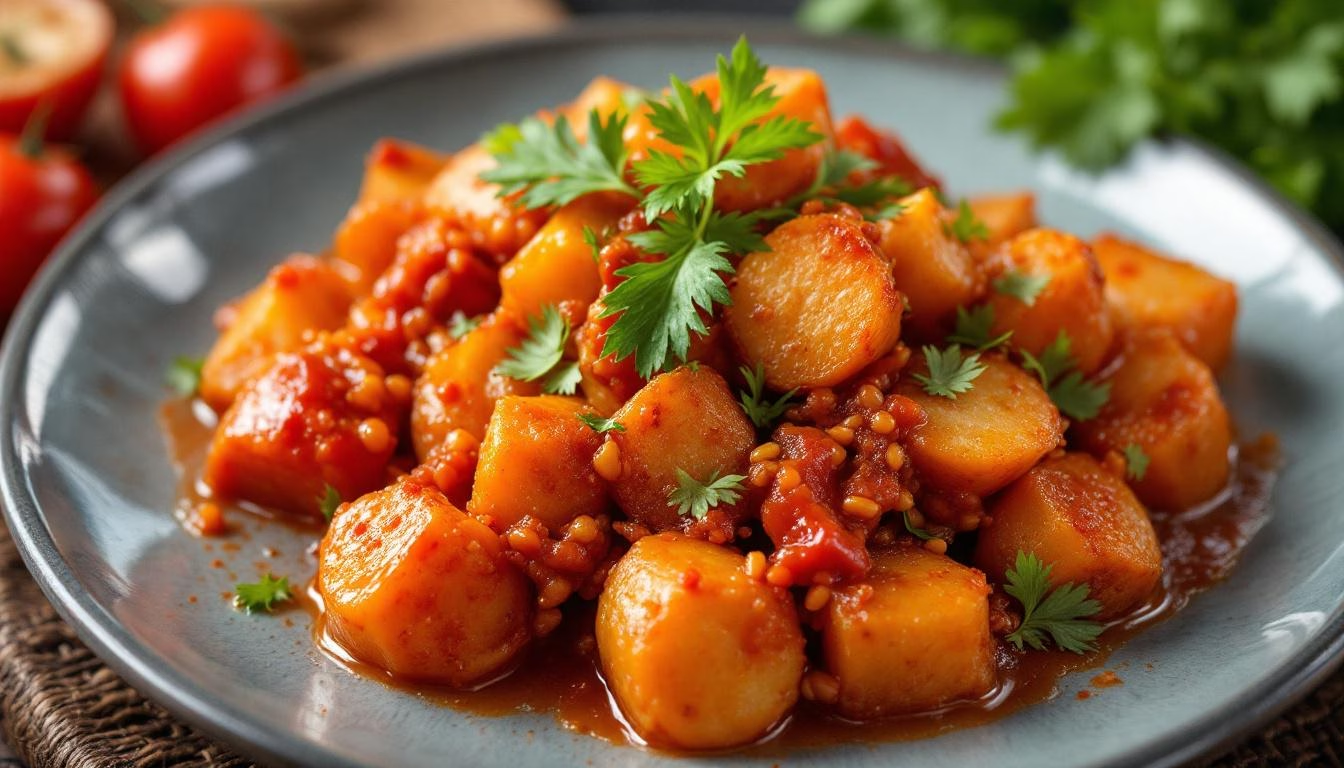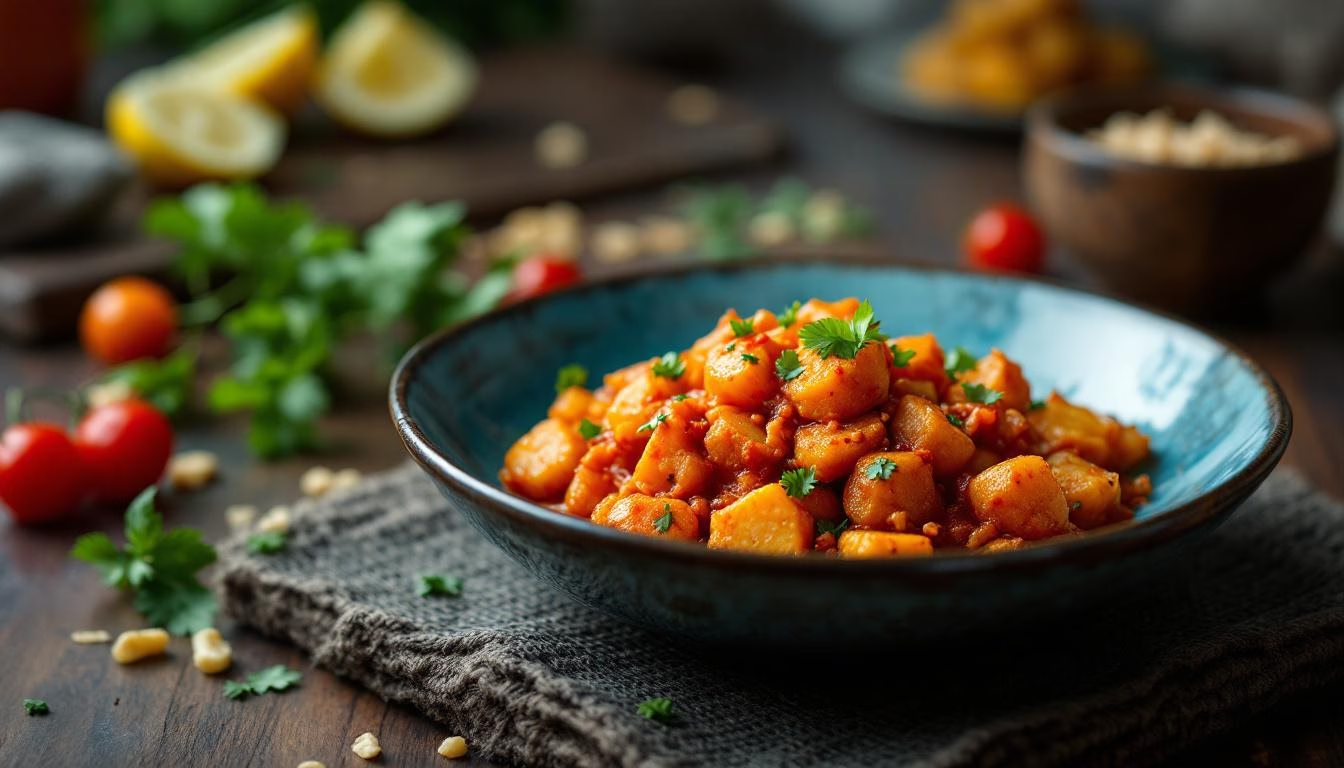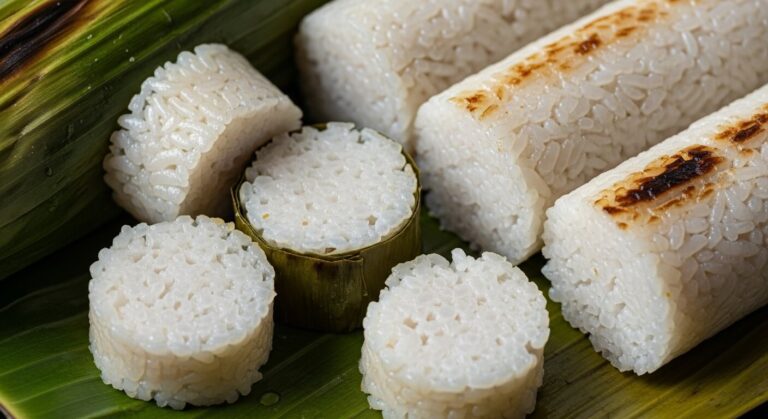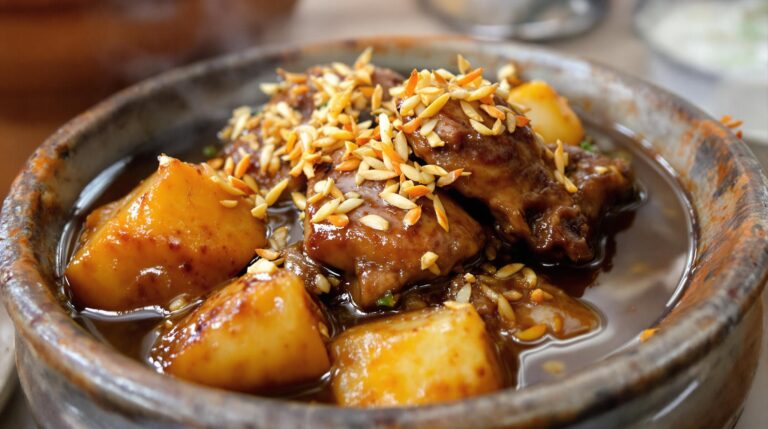Sambal Goreng Kentang Recipe – Spicy Indonesian Potatoes
Crispy Indonesian Sambal Goreng Kentang Recipe – I used to think potatoes were boring. I know, I know – sacrilege, right? But hear me out.
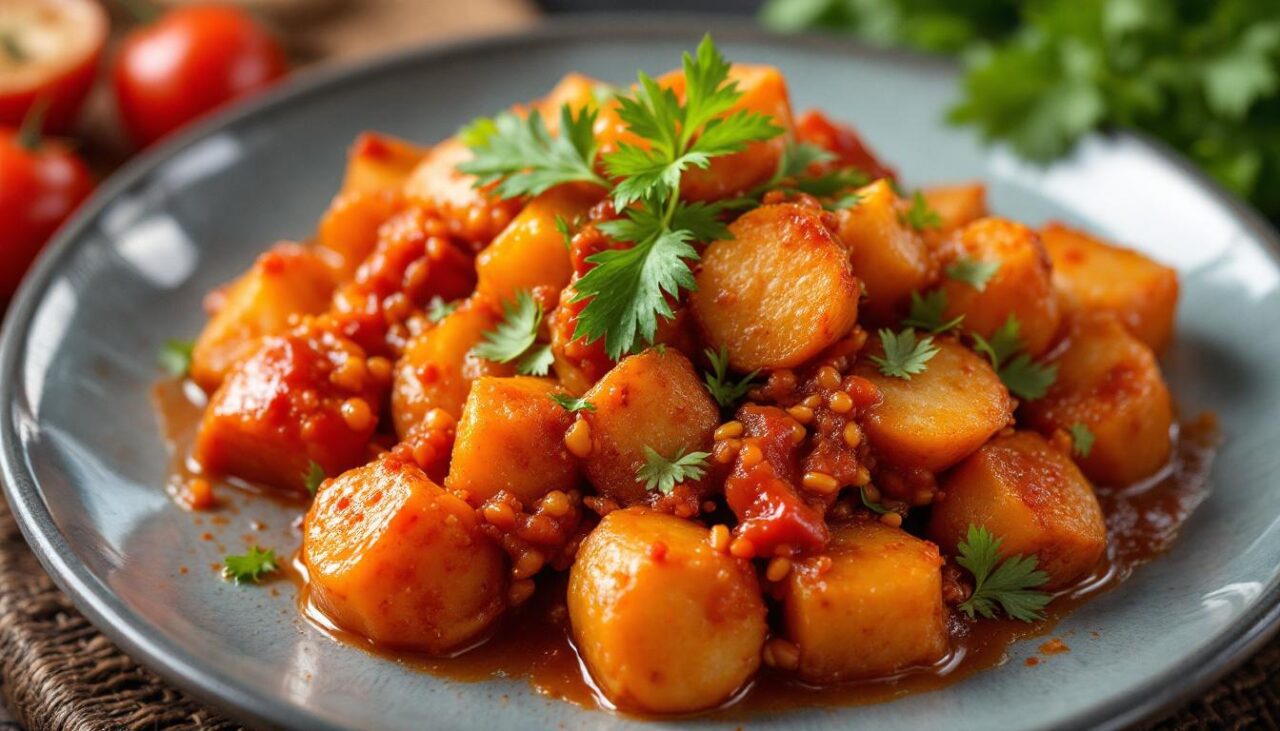
Sambal Goreng Kentang (Spicy Indonesian Potatoes)
Ingredients
- 2.2 lbs. russet potatoes ((1 kg.) peeled and 1 cm. diced)
- 2 cups canola oil (vegetable oil, or peanut oil, for deep-frying the potatoes, or use 2 teaspoons oil if using an air fryer)
- ½ cup shallots (thinly sliced)
- 4 cloves garlic
- 2 teaspoons grated fresh ginger
- 1 teaspoon grated fresh galangal
- 2 Fresno chilis (stems removed)
- 3 bird’s eye chilies (stems removed)
- 1 tablespoon palm sugar (coconut sugar, or brown sugar)
- 1 ¼ teaspoon salt
- 2 teaspoons canola oil (vegetable oil, or peanut oil)
- 2 Indonesian bay leaves (daun salam)
- 4 makrut lime leaves ((A.K.A. kaffir lime or daun jeruk))
- 1 stalk lemongrass (cut in 4 inch sections, bruised, dry external leaves discarded)
- Thinly sliced bird’s eye chilies (to garnish)
- Thinly sliced chives or spring onion (to garnish)
Instructions
- For frying, heat 2 cups canola, vegetable, or peanut oil in a deep pan. When the oil is 350 degrees or hotter, fry the peeled, diced russet potatoes until golden and crispy. For air-frying, coat the potatoes with 2 teaspoons oil and follow your air fryer’s instructions for potato fries. For roasting, bake the oiled potatoes at 400 degrees for 16–20 minutes, until lightly golden all around.
- While the potatoes cook, blend shallots, garlic, grated fresh ginger, grated fresh galangal, Fresno chilis, bird's eye chilies, palm sugar (or coconut sugar or brown sugar), and salt in a blender or food processor until smooth.
- In a dutch oven or wok over medium heat, warm 2 teaspoons canola, vegetable, or peanut oil. After about 90 seconds, when the oil is hot, add Indonesian bay leaves (daun salam), lime leaves, and lemongrass (halved and bruised, with dry outer leaves discarded). Sauté for a few minutes until fragrant.
- Add the sambal paste to the pan and cook until it is aromatic, slightly darker in color, and the oil begins to separate from the paste.
- Drain and add the fried or air-fried potatoes to the sambal mixture. Toss until the potatoes are well coated.
- Serve the Sambal Goreng Kentang garnished with thinly sliced bird's eye chilies and chives or spring onions.
Nutrition
Growing up, potatoes in my house meant mashed with butter, baked with sour cream, or occasionally roasted with rosemary if we were feeling fancy.
They were the reliable sidekick, never the star of the show.
Then I discovered Sambal Goreng Kentang (Spicy Indonesian Potatoes) recipe at a tiny Indonesian restaurant tucked between a laundromat and a nail salon, and suddenly potatoes weren’t boring anymore – they were absolutely electric.
Picture this: golden, crispy potato cubes that shatter when you bite them, revealing fluffy interiors, all coated in a glossy, brick-red sambal that hits you with layers of heat, sweetness, and aromatic complexity.
The first time I tasted this dish, I literally stopped mid-conversation with my dining companion to stare at my fork in wonder.
“What IS this?” I demanded of our server, who smiled knowingly and said, “Sambal goreng kentang.
Very popular in Indonesia.” I proceeded to order two more portions and spent the rest of the meal trying to decode every flavor dancing on my tongue.
That was three years ago, and I’ve been obsessed ever since.
I’ve made this Sambal Goreng Kentang recipe approximately forty-seven times (yes, I keep track in my recipe notebook like the food nerd I am), tweaking and adjusting until I landed on this version that makes my kitchen smell like a spice market and my taste buds do a little happy dance.
The best part?
It’s surprisingly straightforward to make at home, requiring no special equipment beyond a good blender and either a deep pan for frying or an air fryer if you’re trying to be slightly more virtuous about oil consumption.
Authentic Indonesian Sambal Goreng Kentang Recipe
Sambal Goreng Kentang translates roughly to “fried chili potatoes,” but that simple translation doesn’t begin to capture the complexity of this beloved Indonesian dish.
In Indonesia, sambal goreng refers to a whole category of dishes where vegetables, tofu, or proteins are stir-fried with sambal – the country’s ubiquitous chili paste that’s as essential to Indonesian cooking as salt is to, well, everything else.
This particular version focuses on potatoes, which might seem like an odd choice for a tropical country, but potatoes were introduced to Indonesia during the Dutch colonial period and have since become thoroughly integrated into the local cuisine.
What makes this dish distinctly Indonesian isn’t just the sambal, but the aromatic trio of Indonesian bay leaves (daun salam), makrut lime leaves, and lemongrass that perfume the oil and create layers of fragrance that Western potato dishes simply don’t have.
The beauty of Sambal Goreng Kentang lies in its perfect balance of textures and flavors.
The potatoes provide a neutral, creamy canvas for the sambal’s heat and complexity, while the aromatics add a citrusy, almost floral note that keeps the dish from being one-dimensionally spicy.
- Sambal Matah Recipe: Fresh Balinese Condiment
- Easy Sambal Oelek Recipe – Indonesian Chili Paste
- Tahu Goreng Kecap Recipe – Indonesian Fried Tofu
- Indonesian Ketoprak Recipe
- Urap Sayur Recipe: Indonesian Coconut Vegetable Salad
- Javanese Asinan Buah Indonesian Pickled Mango Recipe
- Indonesian Braised Chicken Stew (Semur Ayam) Recipe
- Balinese Spicy Shredded Chicken Recipe (Ayam Suwir Bumbu Bali)
It’s comfort food with attitude – familiar enough to feel approachable, exotic enough to feel special.
Essential Ingredients for Authentic Sambal Goreng Kentang
Before we dive into the cooking process, let’s talk about the players in this delicious drama.
The star ingredients in this Sambal Goreng Kentang recipe each serve a specific purpose, and understanding their roles will help you nail the flavors.
The Potato Foundation
Russet potatoes are my go-to choice here because their high starch content creates that perfect contrast between crispy exterior and fluffy interior when fried.
You want to cut them into roughly 1-centimeter cubes – small enough to cook through quickly, large enough to maintain some textural interest.
I’ve tried this with waxy potatoes like red or Yukon, and while they work, they don’t achieve quite the same satisfying crunch.
Building the Sambal Base
The sambal paste is where the magic happens, and it starts with aromatics that form the foundation of Indonesian cooking.
Shallots provide sweetness and depth, while garlic adds its familiar pungency.
Fresh ginger brings warmth and slight spice, and galangal – ginger’s more citrusy, pine-like cousin – adds a distinctly Southeast Asian note that you can’t replicate with anything else.
For the heat, we’re using a combination of Fresno chilis and bird’s eye chilis.
Fresnos are milder and add bulk to the paste, while bird’s eyes bring serious heat.
If you can’t find bird’s eye chilis, Thai chilis or even small serranos work as substitutes, though you might need to adjust quantities based on your heat tolerance.
The Aromatic Trio
Indonesian bay leaves (daun salam) are different from Mediterranean bay leaves – they’re more citrusy and less bitter.
If you can’t find them, you can substitute with regular bay leaves, but use half the amount.
Makrut lime leaves (sometimes called kaffir lime leaves) provide an intensely citrusy, almost perfume-like aroma that’s irreplaceable.
Lemongrass adds a lemony, grassy note that brightens the entire dish.
Step-by-Step Guide to Perfect Sambal Goreng Kentang
Now that we’ve covered the why, let’s get to the how.
This Sambal Goreng Kentang recipe breaks down into manageable steps that build flavor at each stage.
Preparing and Cooking the Potatoes
Start by peeling your russet potatoes and cutting them into 1-centimeter cubes.
Try to keep them roughly the same size so they cook evenly – this is one of those times when a little precision pays off in the final result.
You have three options for cooking the potatoes, and I’ll be honest about the pros and cons of each.
Deep-frying gives you the absolute best texture – impossibly crispy outside, fluffy inside – but uses a lot of oil.
Heat 2 cups of neutral oil (canola, vegetable, or peanut oil work well) to 350°F and fry the potatoes in batches until golden and crispy, about 4-5 minutes per batch.
If you’re trying to use less oil, an air fryer works beautifully.
Toss the potato cubes with 2 teaspoons of oil and air fry according to your machine’s instructions for potato fries – usually around 380°F for 12-15 minutes, shaking the basket halfway through.
Roasting is the third option: toss the oiled potatoes on a baking sheet and roast at 400°F for 16-20 minutes, flipping once halfway through.
The texture won’t be quite as crispy as frying or air frying, but it’s still delicious and requires the least active attention.
Creating the Sambal Paste
While your potatoes are cooking, make the sambal paste.
In a blender or food processor, combine the shallots, garlic, grated ginger, grated galangal, Fresno chilis, bird’s eye chilis, palm sugar, and salt.
Blend until you have a smooth paste – this might take a minute or two, and you may need to stop and scrape down the sides a few times.
The paste should be relatively smooth but doesn’t need to be perfectly silky.
A little texture is actually nice and adds to the rustic appeal of the dish.
If your blender is struggling, add a tablespoon of water to help things along, but try to keep the paste as thick as possible.
Building the Aromatic Base
In a Dutch oven or large wok, warm 2 teaspoons of oil over medium heat.
Once the oil is hot (about 90 seconds), add the Indonesian bay leaves, makrut lime leaves, and lemongrass pieces.
The lemongrass should be cut into 4-inch sections and bruised with the back of a knife to release its oils, and make sure to remove any tough outer layers.
Sauté these aromatics for 2-3 minutes until they’re fragrant and the oil is infused with their flavors.
Your kitchen should start smelling absolutely incredible at this point – if it doesn’t, give it another minute or two.
Cooking the Sambal
Add the sambal paste to the aromatic oil and cook, stirring frequently, until the paste darkens slightly and becomes very fragrant.
This usually takes 3-5 minutes.
You’ll know it’s ready when the oil starts to separate from the paste and pool around the edges – this is called “oil breaking” and it’s a good sign that the raw flavors have cooked out and concentrated.
Don’t rush this step.
The difference between raw sambal and properly cooked sambal is dramatic – the cooked version is deeper, more complex, and less harsh.
If you taste it at this stage (carefully – it’s hot!), it should be intensely flavorful but balanced.
Bringing It All Together
Once your potatoes are done and your sambal is properly cooked, it’s time for the grand finale.
Drain the potatoes well if you’ve fried them, then add them directly to the sambal mixture.
Toss everything together until the potatoes are completely coated in the glossy red sambal.
Work quickly here – you want the potatoes to stay as crispy as possible.
The residual heat will warm everything through and help the flavors meld, but you don’t want to cook the potatoes further and risk making them soggy.
Pro Tips for Sambal Goreng Kentang Success
After making this Sambal Goreng Kentang recipe dozens of times, I’ve learned a few tricks that make the difference between good and absolutely spectacular.
Timing Is Everything
The key to maintaining crispy potatoes is having your sambal completely ready before you finish cooking the potatoes.
I like to make the sambal paste first, then start my potatoes, and cook the sambal while the potatoes are in their final few minutes of cooking.
This way, everything comes together while the potatoes are at peak crispiness.
Don’t Skimp on the Aromatics
Those Indonesian bay leaves, lime leaves, and lemongrass aren’t just for show – they create the aromatic foundation that makes this dish distinctly Indonesian rather than just “spicy potatoes.” If you can’t find Indonesian bay leaves, regular bay leaves work, but use half the amount as they’re more potent.
Adjust the Heat to Your Preference
Bird’s eye chilis are seriously hot – like, make-you-question-your-life-choices hot.
If you’re sensitive to spice, start with just one and work your way up.
You can always add more heat with extra sliced bird’s eye chilis as garnish, but you can’t take it away once it’s in the sambal.
Make Extra Sambal Paste
This sambal paste is liquid gold and keeps in the refrigerator for up to a week.
I often double the batch and use the extra for stir-fries, as a condiment for grilled meats, or mixed into fried rice.
It’s incredibly versatile and adds instant Indonesian flavor to almost anything.
The Oil Temperature Matters
If you’re deep-frying the potatoes, use a thermometer to maintain 350°F oil temperature.
Too cool and the potatoes absorb oil and become greasy; too hot and they brown before cooking through.
Consistent temperature is key to achieving that perfect crispy exterior.
Creative Variations on the Classic
While this traditional Sambal Goreng Kentang recipe is perfection as written, there are several delicious variations worth exploring once you’ve mastered the basic technique.
Protein Additions
In Indonesia, it’s common to add protein to sambal goreng dishes.
Cubed firm tofu, tempeh, or even hard-boiled eggs work beautifully.
Add them along with the potatoes and toss to coat.
The proteins absorb the sambal flavors wonderfully and make the dish more substantial.
Vegetable Variations
Sweet potatoes make an excellent substitute for regular potatoes, though they’ll caramelize more quickly due to their higher sugar content.
Green beans, cauliflower, or even Brussels sprouts work well with this sambal treatment – just adjust cooking times accordingly.
Heat Level Adjustments
For a milder version, reduce or eliminate the bird’s eye chilis and add more Fresno chilis for bulk.
For the truly brave, add a chopped habanero or scotch bonnet to the sambal paste – but proceed with extreme caution!
Coconut Milk Variation
Some regional versions include a splash of coconut milk added after the sambal is cooked, creating a slightly creamier, richer sauce.
Add 2-3 tablespoons of coconut milk and simmer briefly before adding the potatoes.
Serving Suggestions and Pairings
Sambal Goreng Kentang works beautifully as part of a larger Indonesian meal or as a standout side dish with Western mains.
It pairs particularly well with grilled meats, roasted chicken, or as part of a rice bowl with vegetables and protein.
Traditionally, it’s served as part of a rice table (rijsttafel) alongside other Indonesian dishes like rendang, gado-gado, or satay.
The spicy, aromatic potatoes provide a nice contrast to milder dishes and add textural variety to the meal.
For garnish, thin slices of fresh bird’s eye chilis add extra heat and visual appeal, while chopped chives or spring onions provide a fresh, oniony bite that cuts through the richness of the sambal.
What to Expect: Realistic Results and Final Thoughts
Let me be completely honest about what you’re getting into with this Sambal Goreng Kentang recipe.
This isn’t a throw-it-together-in-ten-minutes kind of dish, though the active cooking time is relatively short.
The prep work – peeling and dicing potatoes, making the sambal paste, gathering aromatics – takes time and attention to detail.
But here’s what you get in return: a dish that’s absolutely bursting with flavor, with textures that play beautifully against each other, and aromatics that will make your kitchen smell like the best Indonesian restaurant you’ve ever been to.
The first time you make it, you might find yourself standing over the pan, stealing crispy, sambal-coated potato cubes with a spoon (not that I’ve ever done this, of course).
The heat level is substantial but not overwhelming if you follow the recipe as written.
It builds gradually and is balanced by the sweetness of the palm sugar and the aromatic complexity of the herbs and spices.
If you’re new to Indonesian food, this is actually a fantastic gateway dish – familiar ingredients prepared in an unfamiliar but absolutely delicious way.
Don’t be discouraged if your first attempt isn’t restaurant-perfect.
Like most dishes with this many components, it gets better with practice.
Pay attention to the visual and aromatic cues in the recipe, taste and adjust as you go, and remember that cooking is as much about the journey as the destination.
Even a slightly imperfect Sambal Goreng Kentang is still going to be pretty spectacular, and definitely more interesting than plain roasted potatoes!

